
So you’ve started your very own restaurant, but you aren’t getting as many customers as you’d like. Well, here’s the thing: simply relying on friends and family to help you spread the word won’t cut it -- you’ll have to come up with a restaurant marketing plan, and put in place specific strategies to promote your restaurant.
According to an Ohio State University study, 60% of restaurants close or change ownership in their first year of business, with a whopping 80% closing within the first five years. It’s no secret that the restaurant business is cut-throat -- this makes it all the more important for you to invest your time and effort into building your brand, and marketing your restaurant.
Want to learn more about restaurant marketing? You’re in the right place. In this guide, we’ll walk you through everything you need to know about promoting your restaurant, including:
- Basic restaurant marketing strategies
- More creative restaurant marketing ideas
- How to turn your ideas into a full-fledged marketing plan
Let’s get started!
8 basic restaurant marketing tips to start off with
You might have plenty of innovative marketing ideas that you’re excited to try out -- but before you do that, take some time to ensure that you’ve covered the basics of restaurant marketing.
1. Know your customer
The key to successful marketing lies in knowing your customer. This is true regardless of your company, industry, and product.

Now, when we say “know your customer”, we don’t just mean knowing the basic demographics (age, gender, where they’re from) of your customers. You have to go beyond that, and understand your customers’ dining preferences and habits, their purchasing power, what it is that they like about your restaurant, etc.
The better you know your customer, the more you’ll be able to tailor your offerings and marketing strategy to suit them. For instance, if most of your customers are middle-aged and married, and tend to come in with their kids, then you might want to consider providing crayons and paper for these kids -- or even setting up a separate play area for the kids.
For restaurants that are patronized heavily by families, having child-friendly facilities is really a win-win. Your customers get a better experience, and because they can linger over drinks and dessert instead of cutting their meal short, this also increases your Average Order Value (AOV).
2. Nail your branding
Why is branding important? Well, building a strong brand can help you attract new customers and grow your revenue, and it’s essential for any restaurant that hopes to survive and thrive in the long run.
Let’s break it down: when you have a strong brand, this helps to generates buzz and drive more business to your restaurant. On top of that, having a strong brand also allows you to price your products (in this case, your menu items) at a premium, without experiencing any major drop-off in sales. Just look at Apple, whose phones are highly sought after even though they’re mind-blowingly expensive.
So, how do you nail your branding? With your target audience in mind, think about how you want your customers to perceive your brand. If you’d like, you can explore this in terms of the Five Dimensions of Brand Personality, which is a framework that marketers use to describe and measure the “personality” of a brand:
- Sincerity (down-to-earth, honest, wholesome, cheerful)
- Excitement (daring, spirited, imaginative, up-to-date)
- Competence (reliable, intelligent, successful)
- Sophistication (upper class, charming)
- Ruggedness (outdoorsy, tough)
Regardless of which brand personality you choose, make sure that all the elements of your restaurant (decor, menu, entertainment) complement one another. You don’t want to confuse your customers by sending them mixed signals with your branding and marketing.
Say you choose to brand your restaurant as “Sophisticated”, for example. You might want to start playing jazz or classical soundtracks in your restaurant, instead of streaming the latest pop hits. On top of that, you could also rework your offerings and come up with special fine-dining menus that feature gourmet, artisanal ingredients.
3. Claim and optimize your Google My Business listing
What’s your Google My Business listing? It’s the listing that appears when someone searches for your restaurant (or for restaurants in the area) on Google or Google Maps. Here’s what this listing looks like:

To make the most out of your listing, you’ll want to claim it and populate it with as much information as possible.
What’s the rationale behind this? When you have a completely filled out listing, this makes your restaurant more attractive to diners who are researching restaurant options, and ultimately drives more traffic to your restaurant.
On top of that, you’ll also appear higher up in the results when people search for related queries (see below). Because Google has more context about your restaurant, it’ll recommend your restaurant over restaurants with non-optimized listings.

To claim your listing, simply head to Google My Business and click the “Start now” button. Once you’ve claimed and verified your business, start filling out your profile:
- Make sure your NAP (name, address, phone number) and other information is filled in and up-to-date
- Input your business category (American Restaurant, Asian Restaurant, etc)
- Add attributes to tell your customers if your restaurant offers Wifi, outdoor seating, and other amenities
- Add your menu
- Add pictures that showcase your restaurant
- Add videos, if you have any
- Respond to reviews and questions, if any
To learn more about optimizing your Google My Business listing, check out Google’s guide.
4. Get listed on review sites such as Yelp
What do consumers do when they can’t decide where to eat? They turn to Yelp.
Yelp averages more than 178 million unique visitors every month, and a whopping 82% of consumers visit Yelp because they’re intending to make a purchase. That’s not all -- according to a Boston Consulting Group study, businesses who are on Yelp experience an increase of $8,000 in annual revenue on average; this revenue is directly attributable to the site.

So, how can you use Yelp to drive more traffic to your restaurant? Like how you’d do with Google My Business, you’ll have to claim your listing, fill in your restaurant profile, and respond to reviews. To learn more about optimizing your Yelp profile, check out this step-by-step guide.
Once you’re good to go with Yelp, check out these other customer review sites that you can also use to reach out to more customers.
5. Optimize your website for SEO
Don’t know much about SEO, and find it a tad intimidating?
Don’t worry, we’ll break it down for you. SEO basically comprises of the following elements:
- Off-page SEO: getting backlinks (links from external websites that point to your website), which also helps with your search ranking.
- On-page SEO: content -- creating content that’s targeted at specific keywords, so that you can rank for these keywords.
- On-page SEO: technical -- structuring your website in a way that allows Google’s crawlers to find and index your content effectively.
First, when it comes to off-page SEO, you’ll want to get your website listed on as many directories and review sites as possible. When there are several websites that link to your website, this tells Google that you’re a legitimate site that can be trusted, and increases the chances that you’ll be ranked highly for your keywords.
Next, a crucial part of on-page SEO is to engage in keyword research to find the ideal keywords to rank for, then create content that’s optimized around these keywords. To learn how to do keyword research for your restaurant, check out this guide by Typsy. To learn how to optimize your content (blog posts, website pages, etc) around the keywords you’ve identified, read this HubSpot guide.
Finally, you’ll also have to structure your website in a way that makes it easy for Google to crawl and index your content. We’re talking about setting up your sitemaps, linking to your social media profiles on your website, ensuring that your site is SSL-certified, etc.
We’re not going to lie -- if you’re a beginner at SEO, you might find it tough to navigate each of these elements on your own, which is why we’re going to quickly plug our DIY SEO tool here.

This tool is exceptionally simple to use: just input your website URL, and it’ll conduct a full audit of your website. After identifying the problems with your site, the tool will also recommend a list of fixes (and walk you through how to tackle each fix).
Want to try out our DIY SEO tool? Get your 14 day free trial here.
6. Create social media profiles (and post regularly)
In this day and age, social media is a crucial component of marketing. Plenty of consumers use Facebook, Instagram, and other platforms to research restaurants and dining options -- so it’s in your best interests to set up your social media pages, and frequently post on them.
If you’re wondering what social media platform you should focus on, this really depends on the target audience that you’re marketing your restaurant to. For you want to reach out to a middle-aged, more affluent crowd, go with Facebook; if you’re catering to a younger audience, Instagram might be a better bet.
Once you’ve secured and set up your social media profile, start posting regularly. We recommend once a day if possible; if not, try and post at least twice or thrice a week. Content-wise, you’ve got plenty of options to play around with. You can post behind-the-scenes pictures of your employees at work:

Restaurant updates:
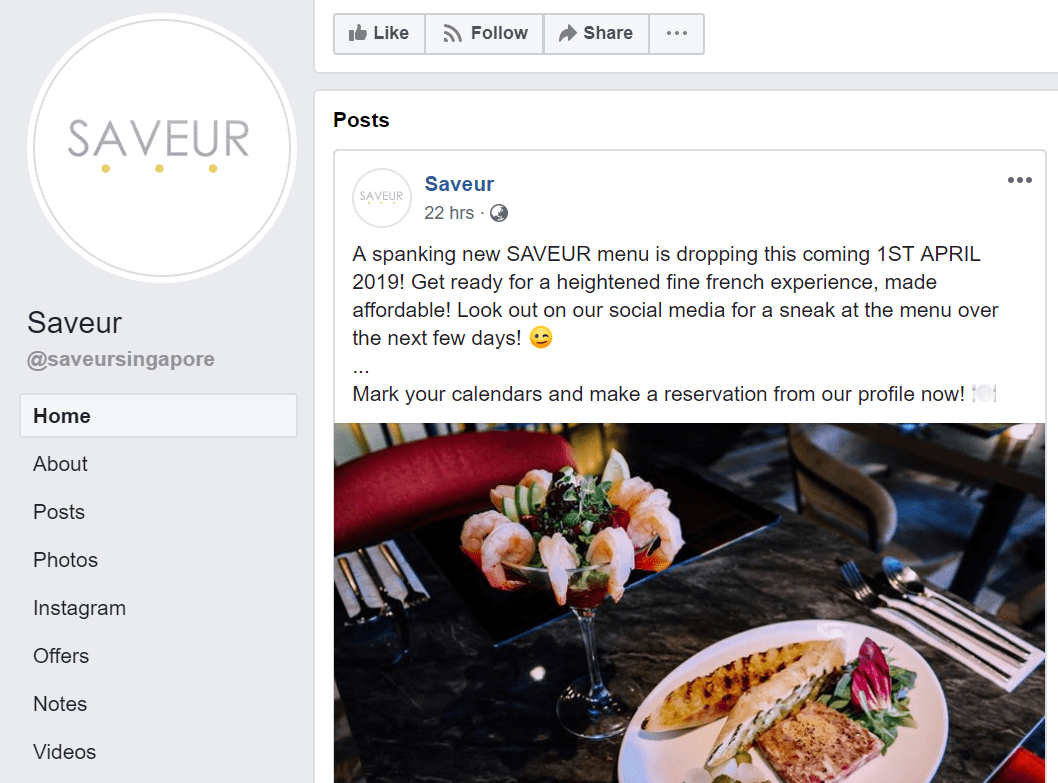
Showcase specific menu items:
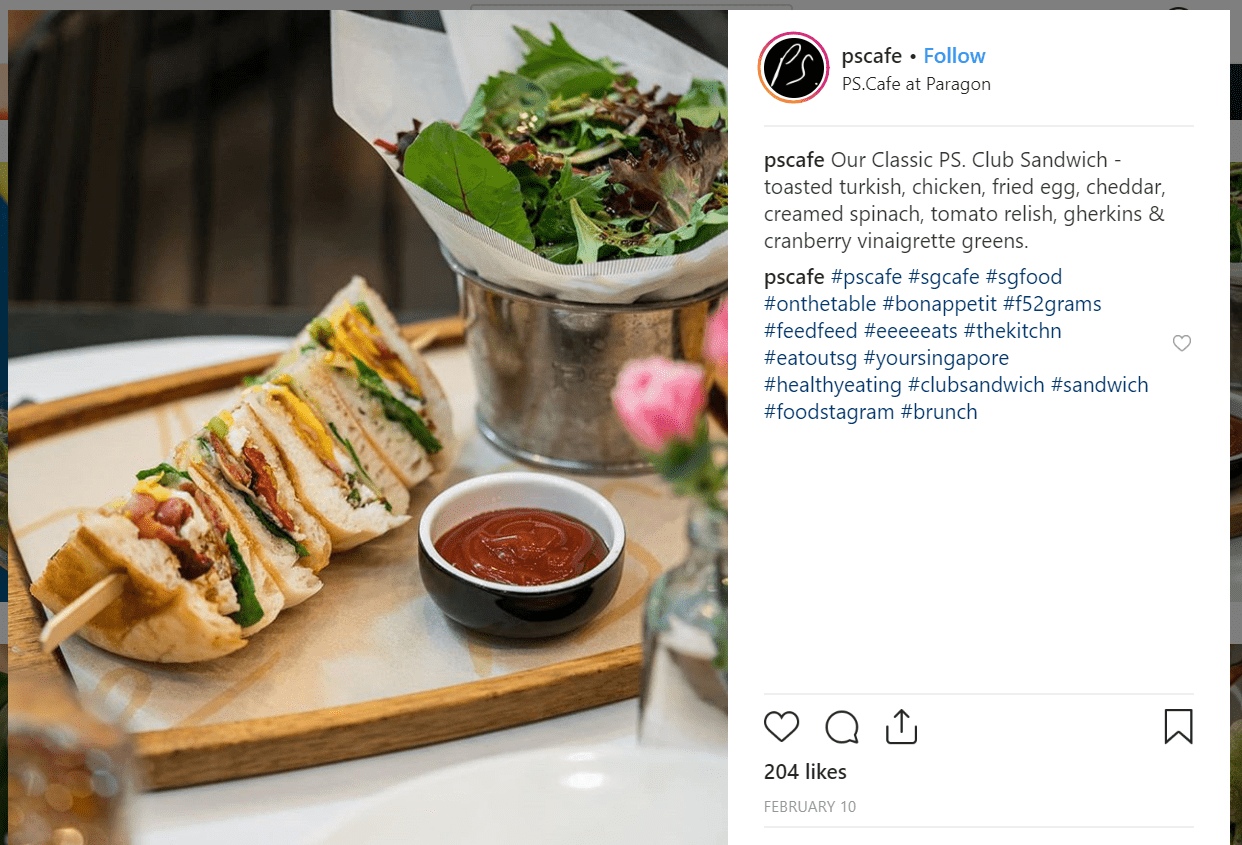
And even re-post pictures and reviews from your customers:

To keep track of all your posts (across all platforms), we recommend using Hootsuite. If you find it too troublesome to log in to your accounts and post everyday, you can sit down for an hour or two each week, and schedule all your posts at once.
7. Create a loyalty program
Apart from marketing your restaurant to new customers, you should also be reaching out to your existing customers, and trying to turn them into loyal diners. Recruiting new customers costs five times as much as retaining current customers, so focusing all your time and effort on your new customers (and neglecting your existing ones in the process) will definitely be counter-productive.
Now, one of the best ways to engage your existing customers and keep them coming back is to create a loyalty program. There are various ways you can do this, including:
- Awarding your customers points that they can then spend
- Allowing your customers to unlock discounts
- Allowing your customers to unlock freebies
You can either reward your customers based on their dollar spend, or the number of times they dine at your restaurant -- it’s up to you.
The simpler and more straightforward the rules of your loyalty program, the more effective it’ll be. For instance, if your program states that your customer can redeem a free side on their fifth visit to your restaurant, don’t throw in multiple caveats saying (1) that this is only applicable on weekdays, and (2) your customer has to post about your restaurant on social media before they can redeem their side.
8. Plan campaigns that tie into holidays and festivals
Campaigns, promotions and discounts are a great way of reaching out to new audiences, and incentivizing more folks to dine at your restaurant.
Bearing this in mind, sit down and identify all the major holidays and festivals across the year, and come up with a few campaigns to run in conjunction with these holidays. For instance:
- Valentine’s Day: Special Valentine’s Day menu, with free flowers for every couple that purchases this menu
- International Women’s Day: 10% off for women who dine in a group of 4 or more
- St Patrick’s Day: Come dressed in green to enjoy 1-for-1 appetizers
- Earth Day: Bring your own containers for takeaways and get 5% off your bill
- Mother’s Day / Father’s Day: Dine with your family and your bill will be discounted based on how many generations are present. Diners with 2 generations get 10% off, and those with 3 generations get 20% off.
- 4th of July: Offer a special 4th of July menu
- Oktoberfest: Add new craft beers to your menu, offer a special beer tasting menu, offer 1-for-1 during Happy Hour
6 creative restaurant marketing ideas to try
Now that we’ve covered the basics, let’s move on to discussing the more creative marketing strategies that you can use to promote your restaurant.
1. Enlist the help of ambassadors
In a survey of 28,000 respondents, Nielsen found that 92% of consumers trust brand advocates above all other forms of advertising. Bearing this in mind, enlist your loyal customers to be your ambassadors, and get them to promote your restaurant on social media.
How do you work with brand advocates? At the most basic level, you can simply invite these brand advocates to food tastings and events, and get them to post about your restaurant on social media. Remember to ask them to tag your brand and/or use your branded hashtags while they’re at it!
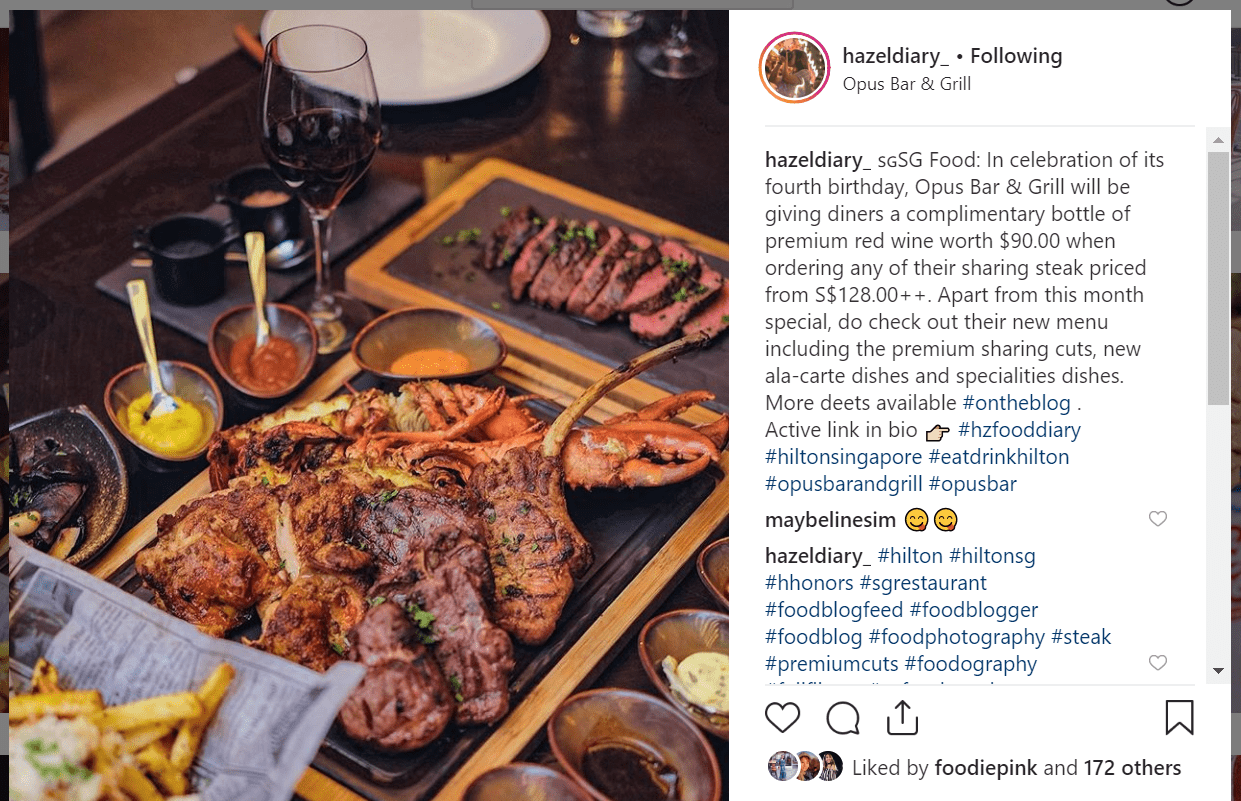
Want to monitor your results so that you can fine-tune your strategy? Make sure you come up with a way of tracking the number of “leads” or restaurant visitors that each brand advocate brings you.
If you’re getting your advocates to share booking links online, you can create custom URLs for each advocate using Bitly; this allows you to track the number of click-throughs on each link. Alternatively, tell your brand advocates to ask their followers or network of friends to quote their name at your restaurant for a 5% discount.
This way, you can keep track of how many actual referrals that you get from each brand advocate. From there, evaluate the type of posts and posting strategy (eg: how often do they post? How many hashtags do they use?) of each advocate, and fine-tune your strategy accordingly.
2. Come up with an Ultimate Challenge
Food eating challenges are a great way to create buzz, and draw new customers to your restaurant.
The premise of these challenges is simple: create a monstrous-looking dish, challenge a diner (or a group of diners) to finish it within a certain amount of time, and come up with some sort of award or incentive for diners who are able to deliver.

For instance, Exeter’s Urban Burger Restaurant challenged its diners to finish a humongous burger featuring seven 6-ounce burger patties, 14 slices of bacon, 7 slices of cheese, and 2 giant portions of double-fried fries (pictured above). Those who were able to get everything down in 20 minutes would get the meal on the house, and be awarded with a free t-shirt.
Like Exeter’s Urban Burger, many restaurants who do these challenges simply state that winners are rewarded with a free meal (the one they’ve just consumed). But if you want to entice more diners to participate, you can do this with a more attractive reward (for instance: winners get their picture displayed on your Hall Of Fame, plus one year’s worth of free meals at your restaurant.)
3. Create a highly Instagrammable dish
In the era of social media, restaurant food doesn’t just have to taste good -- it’s also important for it to look good. The more “foodporn-worthy” or Instagrammable your menu is, the more attention you’ll get on social media.
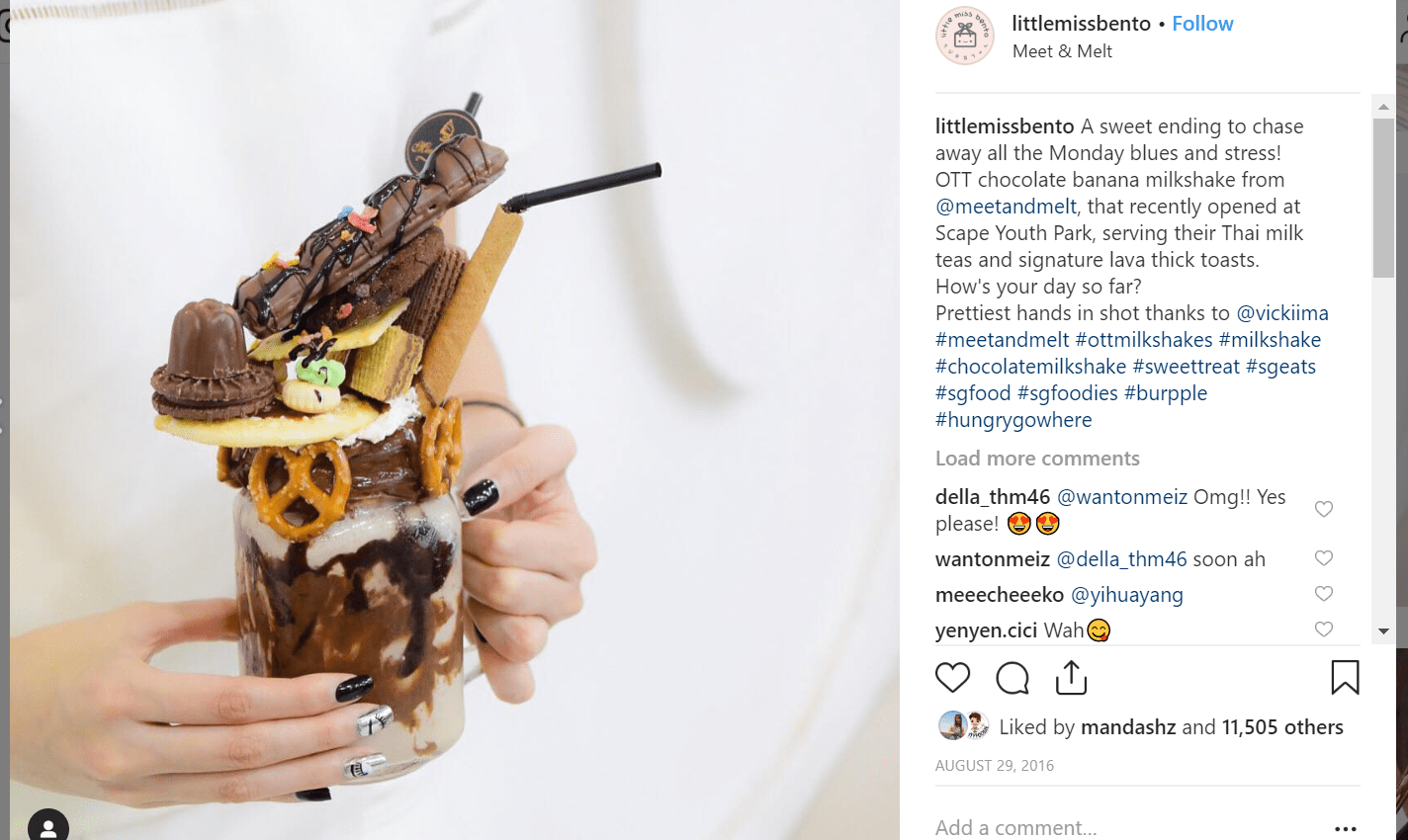
What makes a dish foodporn-worthy or Instagrammable? Here are a few things to take note of:
- Colorful dishes are generally well-received on social media. Think rainbow cake, galaxy cake, and pink milkshakes.
- The more cheese is in your dish, the more Instagrammable it is. Bonus points if it’s soft and oozing.
- The more decadent your dish looks, the more Instagrammable it is. A burger with two patties isn’t anything to write home about, but a burger with six patties… now that will get people to pay attention.
- If your dish possesses an element of interactivity, that works as well. For instance, flambéing your dish in front of diners brings about a “wow” factor.
4. Incentivize customers to review your site
The numbers don’t lie: 93% of local consumers use reviews to determine if a local business is good or bad, and 87% of US-based consumers need a business to have a minimum star rating of three (out of five) to use it.
If you haven’t already got a review strategy in place, it’s time to set one up now. You can keep things fairly simple -- put a leaflet in your table standees to let customers know that they can get a free dessert or 10% off their next bill if they leave you a review on Facebook, Yelp, or Google.
Don’t forget to periodically check in on your reviews, and follow up with your dissatisfied customers (if any)!
5. Run a class, workshop, or event
Another marketing strategy that you can use to gain more exposure for your restaurant? Run a class, workshop, or event to get more people through your doors.
Some events you could run include:
- Wine appreciation class
- Wine & cheese night
- Cocktail-making workshop
- Introduction to Whisky masterclass
- Basic barista course
- Kombucha-making workshop
- Parent & child baking class
- Parent & child cooking class
Make sure you publicize whatever you’ve got planned by creating a Facebook event, and post about it on your other social media channels as well.
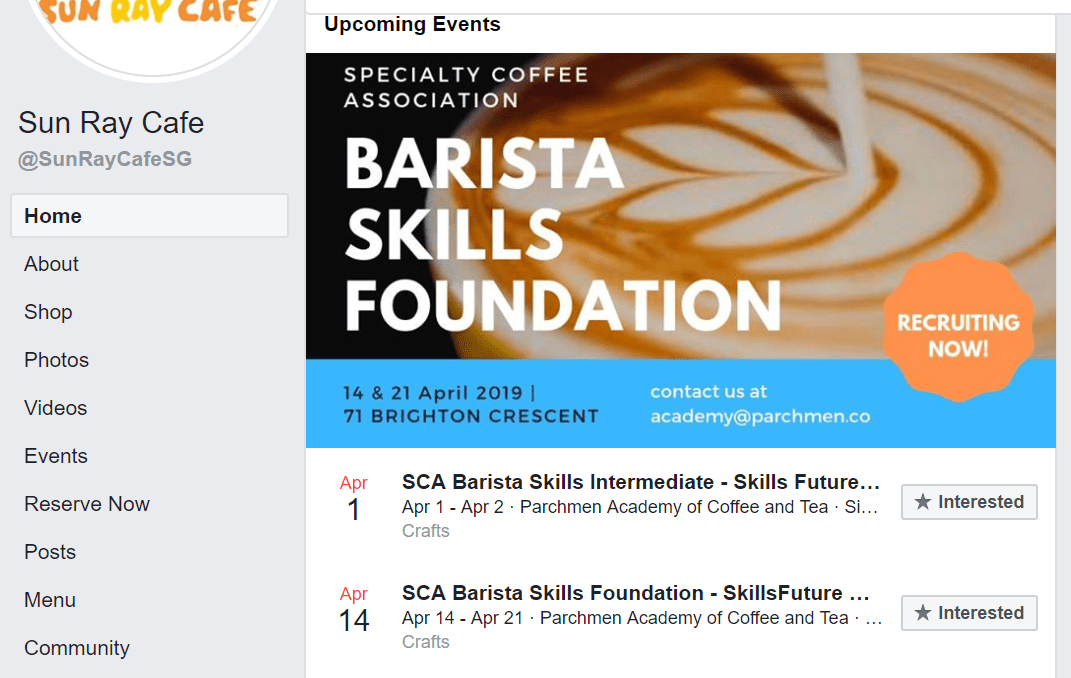
To maximize your reach, also get your friends, family and colleagues to share your posts with their own networks
6. Take your audience behind the scenes
To the layperson, running a restaurant (or any sort of F&B business) is pretty dang cool. To capitalize on this, take your audience behind the scenes and give them a glimpse into the day-to-day operations of your restaurant. For instance:
- Showcase how to cook your signature dish(es)
- Get your chefs to share cooking tips and tricks
- Invite your followers to ask questions about your restaurant, and answer these questions
- Interview and profile the various members of your team
- Invite your customers to come to your restaurant and experience a day in the life of a chef or restaurateur
You can start a YouTube channel, or simply share your content with your followers via Facebook Live or Instagram’s IGTV. We recommend experimenting with a few channels and formats, and seeing which works best for you.
6 steps that will help you turn your ideas into a full-fledged marketing plan
Now that you’ve got all these amazing ideas that you want to try, go ahead and turn these into a full-fledged marketing plan.
Step 1: Determine your goals.
Obviously, the overarching goal is to drive more customers to your restaurant, but think of exactly how you want to achieve this.
If you’re already nailing your word of mouth, but you’ve neglected social media, you might want to use social media to generate more customers. If you’re great with getting new customers through the door, but these customers don’t typically return again, then it makes sense to work on your retention rate.
If possible, try and quantify each goal, and contextualize it within a specific timeframe. Here’s an example:
- DON’T say: I want to increase the customers I get from social media.
- DO say: I want to increase the customers I get from social media by 50% within the next three months.
Step 2: Make sure you can be found online.
Now that you’ve identified your marketing goals, move on to establishing a digital presence. To recap, here are the things you’ll have to do:
- Claim your Google My Business listing
- Get listed on review sites such as Yelp
- Optimize your website
- Create your social media profiles
In the spirit of full disclosure, it does take some time to set these things up properly. But on the bright side, once you’ve optimized each of these elements, that’s the bulk of the work done. While you’ll still have to check in and “maintain” each component (eg reply reviews on Google My Business), this won’t eat up too much time.
To streamline and simplify your process, you’ll want to make full use of tools such as our DIY SEO software, and the various keyword research tools out there.
Step 3: Come up with a social media marketing strategy.
With social media, it’s not enough to have an empty “shell” of a page that simply lists out your restaurant’s information. You should also post on a regular basis; this helps entice customers (both new and old alike) to visit your restaurant.
To keep track of what content needs to be published on your social channels and when, use CoSchedule’s Social Media Content Calendar. Once you’ve gotten your posts worked out, schedule these posts in advance with Hootsuite, so that you won’t have to remember to post every single day.
Pro-tip: Wondering what’s the best time to post in order to receive maximum views and engagement? Check out this HubSpot guide.
Step 4: Plan your marketing campaigns for the rest of the year.
Like how you’ve planned out your social media posts, go ahead and plan out the marketing campaigns that you want to run for the rest of the year. Here, we recommend going with a mix of “standard” campaigns that are tied to holidays, and more creative marketing campaigns that you want to experiment with.
If you’re working with a team and you need a project management tool that allows everyone to collaborate on these campaigns, we recommend Trello. You can set up different “cards” for each campaign that you’re planning...
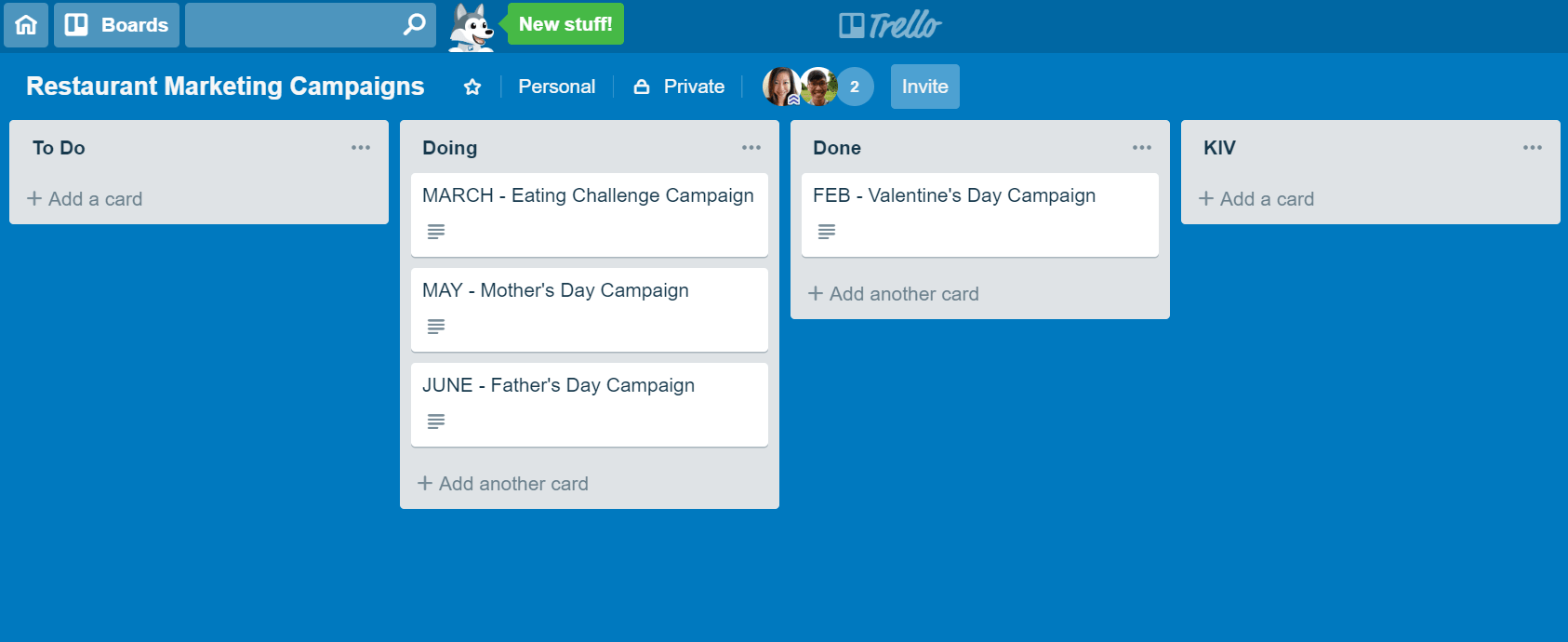
And add members, checklists, due dates, and attachment to each campaign:
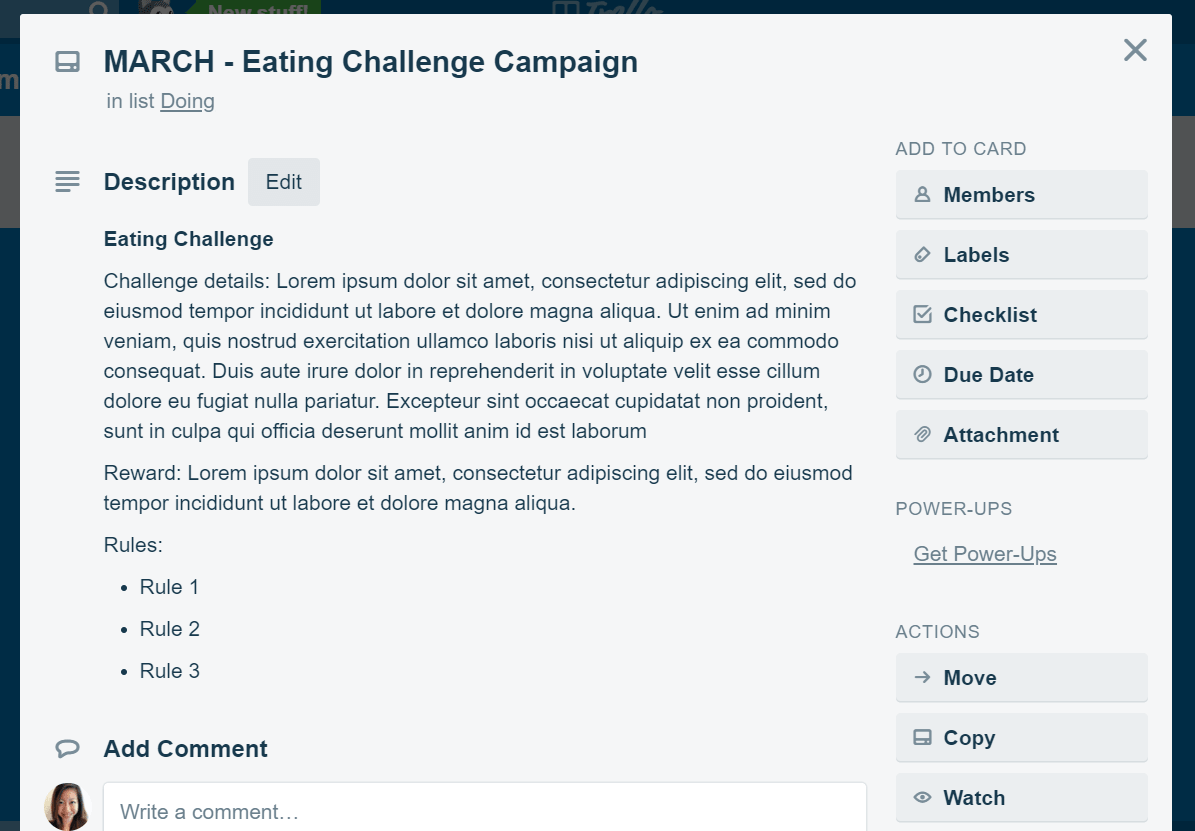
Step 5: Identify key metrics to track.
After planning out your social media posts and campaigns, don’t forget to identify key metrics to track. If you don’t do this, you won’t be able to (accurately!) weigh up the effectiveness of your marketing efforts.
Social media metrics to track include:
- Engagement rate (Likes, Comments, Shares)
- Growth in followers
- Clickthrough rate (links in bio / profile)
- Clickthrough rate (links in posts)
If you’re using Facebook, dig into your Audience Insights to find out which of your posts are doing the best. If you’re on Instagram, you can also access Instagram Insights, assuming you’ve created a Business Profile (not a personal one).
As for campaign metrics, the exact metrics you should track depends on how you intend to promote your campaign. To learn more, read this guide on how to select marketing metrics and KPIs to monitor.
Step 6: Execute and evaluate the effectiveness.
The final piece of the puzzle is to execute your marketing plan, and evaluate its effectiveness.
First, benchmark your results against the marketing goals that you set in Step One of this process. If you hit your goal, kudos to you. If not, look at your marketing metrics and try and identify what caused you to fall short. Was your reach insufficient? Did people simple share your campaign, without participating? Once you can roughly guess what went wrong, you can tweak your campaign strategy and try again.
On top of that, also calculate the ROI of your marketing campaign to figure out if it improved your bottom line. Here’s a simple formula that you can use:
ROI = Net Profit / Total Investment x 100
For instance, say you ran an eating challenge in the month of April, and your expenses and revenue generated are as such:
Diners who participated in campaign = 52 (50 losses, 2 wins)
Average Order Value (AOV) per diner = $50
Expenses: $300 on materials for publicity + $500 on prizes + $15 for cost of food for each successful participant
Total expenses = $830
Here are the relevant calculations:
Total revenue generated = $50 x 50 = $2,500
Profit = $2,500 - $830 = $1,670
ROI = $1,670 / $830 x 100% = 201%
This means you achieved 201% ROI with your eating challenge -- that’s not too shabby at all! You might want to consider implementing this into your long-term restaurant marketing strategy, and creating new challenges every quarter.
A final word on restaurant marketing
Give yourself a pat on the back for making it all the way to the end of this guide! You’re now an unofficial expert on restaurant marketing, and you’ve got everything you need to drive more traffic to your restaurant.
If you’ve got any questions on the marketing strategies and techniques we’ve outlined above, feel free to comment below. Otherwise, full steam ahead!










